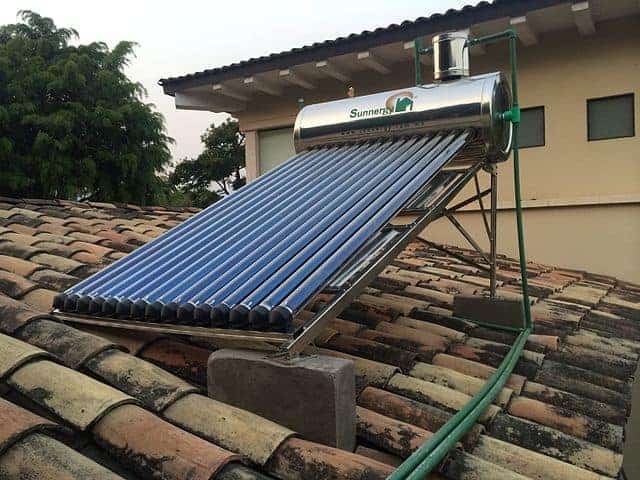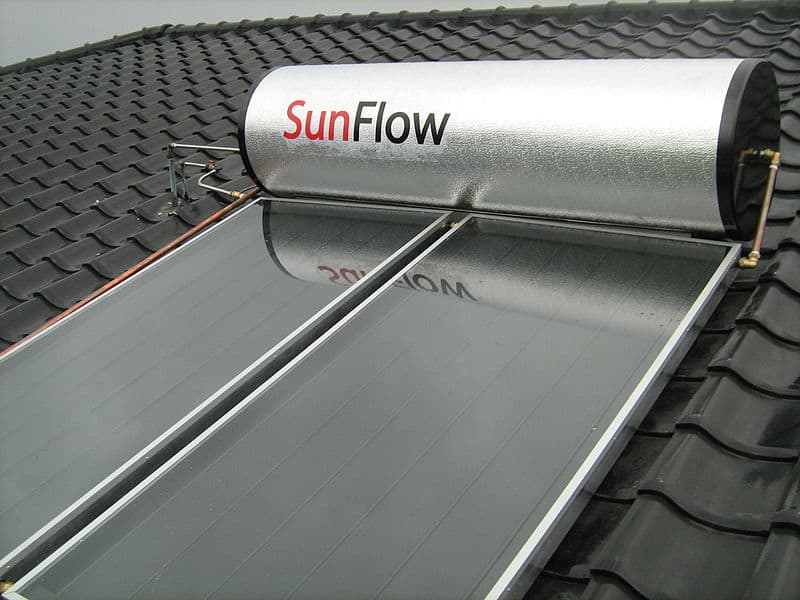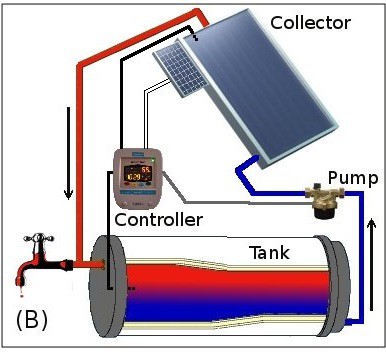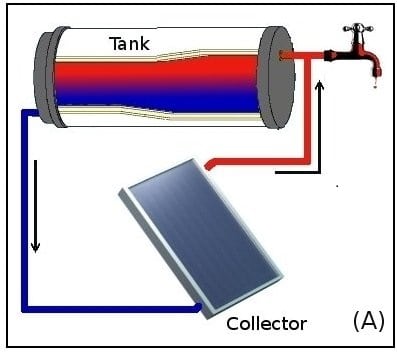Table of Contents
What type of solar geyser is best?
In this guide, we compare the types of solar geysers in Zimbabwe or South Africa. These are:
- Evacuated Tube versus Flat Plate Collectors
- Direct versus Indirect systems
- High pressure versus low pressure
- Passive versus Active systems
These are four simple comparisons of solar geyser systems that will help you when you shop around.
This is a detailed post. If you’re new to solar water heaters, read my beginner’s guide to solar geysers first.
If you’re already up to speed on the basics read on.
Evacuated Tube vs Flat Plate Collectors
This is one of the most important distinctions you need to know if you’re looking to buy solar geysers in Zimbabwe.
Most solar geysers for residential or commercial properties use one of these. They’re the most popular because they’re the most effective.
Evacuated Tube Collectors
These were originally designed for colder European countries.
Evacuated Tube Collectors (ETCs) have rows of transparent glass tubes sunlight heats through which water or heat transfer liquid. The hot water then rises into the tank above through convection.

Pros of an Evacuated Tube Collector
- Most commonly stocked, so they’re the easiest to get. Evacuated tube collectors are the most popular type you will find when looking for solar geysers in Zimbabwe.
- They can track the sun for longer than flat plates. This makes them more efficient, especially in winter when the sun is lower in the sky.
Cons
- The entire unit is installed on your roof. Some people don’t like how that looks.
- They’re more expensive than Flat Plate Collectors.
Flat Plate Collectors
A solar flat plate collector uses a heat absorbing plate.
Usually, it’s a large sheet of copper or aluminium painted black to absorb as much sunlight as possible.
Parallel copper tubes run down the length of the sheet surface. These tubes carry the water or heat transfer liquid that’s heated by the sun.

Pros of a Flat Plate Collector
- They are cheaper than Evacuated Tube Collectors.
- Nicer to look at since you have the option of getting a split collector that allows you to have only the collector up on the roof.
Cons
- They are up to 25% less efficient than Evacuated Tubes.
Which one is better?
While ETC’s might be more expensive, they’re more efficient than Flat Plates.
In the summer, this might not be as important.
In winter, when the days are shorter and you’re the last in line to take a bath, this will be critically important.
Winner: Evacuated Tube Collector
High pressure vs Low pressure solar geysers
High pressure or low pressure is about the water pressure of your solar geyser.
Both ETC’s and Flat Plates can be low or high pressure.
Low pressure
In low-pressure solar geysers, water comes into the geyser through gravity. The water might come from an above-ground tank that’s placed higher than the geyser, for example.
Low-pressure geysers are ideal where you don’t have a main/city council water connection. This might be a farm or lodge or any other off-grid location.
Pros of a low pressure system
- Cheaper than a high-pressure solar geyser.
- The lower pressure means less stress on the tank and collectors, thus it has a longer lifespan than a high-pressure geyser.
Cons
- More suited to an off-grid location where there is no council water.
- You get water at lower pressure.
High pressure
High-pressure solar geysers are designed for mains/city council water supply.
Provided the pipes are the same diameter, you will get the same water pressure from your hot water tap as from your cold.
Pros of a high pressure system
- Higher water pressure.
- Can be retrofitted to an existing storage tank.
Cons
- They are more expensive than low-pressure solar geysers.
Which one is better?
This one is tricky to call. If you’re in a residential area and you have council water, it’s better to go for the high-pressure geyser.
If you don’t have council water and you’re not using a pump, a low-pressure geyser might serve you better.
Winner: Tied
Direct vs Indirect systems
A solar water heater heats water directly or indirectly. Both ETC’s and Flat Plate Collectors can be direct or indirect.
Direct systems
With a direct system, the solar thermal collector heats the water itself.
Pros of a direct system
- Cheaper than an indirect system since there’s no use of a heating liquid.
- It’s more efficient since the water is heated directly.
- Less maintenance since there’s no heating liquid to replace.
Cons
- Water quality is an issue. Chemicals in the water can affect the collector and lead to corrosion of its components.
Indirect systems
In an indirect system, a heating liquid is heated by the sun in the collector. Once hot, the liquid heats the water through a sleeve or pipes.
Pros of an indirect system
- Unlike water heating liquid is non-corrosive. This gives the system a longer lifespan.
- The heating liquid has better heat retention, especially in cold weather.
Cons
- Pipes and sleeves take up space. A smaller volume of water comes into contact with either. This makes an indirect system less efficient.
- More maintenance through needing to replace the heating liquid (every 3-8 years).
Which one is better?
Direct systems have less maintenance and they’re more efficient. They’re also cheaper. They do however require cleaner water.
Winner: Direct systems
Active vs Passive systems
Passive or active describes a solar geyser system that uses/doesn’t use a pump.
Active system
In an active system, a pump is used to circulate water or heating liquid through the system.
Usually, an additional solar panel is added to power the pump.

Pros of an active system
- It’s more efficient since circulation through the system is powered by the pump.
- More control over the system.
- Excess power from the panel used on the pump can be diverted to other uses in the house.
Cons
- It’s more expensive since you’re adding more components to the system.
Passive system
In a passive system, there is no pump used to circulate the water or heating fluid through the system.

Pros of a passive system
- It’s cheaper and easier to operate since there are fewer components.
Cons
- It’s less efficient.
- Less control over the system.
Which one is better?
This is another hard one to call. A passive system is easier to operate and maintain, but less efficient.
An active system is more efficient but is more expensive and has more moving parts. There are tradeoffs on both ends.
Winner: Tied
Final verdict
That covers every major aspect of a solar water heater. Which solar geyser system is the best for you? That depends on several factors including:
- How much you want to spend.
- Your water supply source.
- Any other considerations unique to you.
If you’re looking for the least expensive option, then what you want is a low pressure, direct system flat plate collector without a pump.
For best performance you want a high pressure Evacuated Tube Collector that uses a direct system and a pump.
For most people, however, getting a high pressure Evacuated Tube Collector without a pump is the best option.
It’s simple, it gets the job done, and there isn’t the added expense and maintenance of a pump.
How solar-ready are you? Take the five minute Solar 101 Quiz and find out!